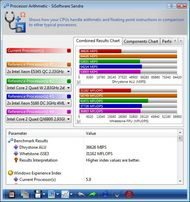
How we configured our test systems: When configuring our test systems for this article, we first entered their respective system BIOSes and set each board to its "Optimized" or "High performance Defaults". We then saved the settings, re-entered the BIOS and set memory timings for either DDR2-1066 (AMD) with 5,5,5,15 timings or DDR3-1066 - 1600 with 7,7,7,20 timings (Intel). The hard drives were then formatted, and Windows Vista Ultimate was installed. When the Windows installation was complete, we updated the OS, and installed the drivers necessary for our components. Auto-Updating and Windows Defender were then disabled and we installed all of our benchmarking software, defragged the hard drives, and ran all of the tests.
 |
| HotHardware's Test Systems |
| Intel and AMD - Head To Head | |
|
System 1:
Core 2 Extreme QX9770
(3.2GHz - Quad-Core)
Core 2 Extreme QX9650
(3.0GHz - Quad-Core)
Core 2 Quad Q6600
(2.40GHz - Quad-Core)
Core 2 Duo E6850
(3.0GHz - Dual-Core)
Core 2 Duo E6600
(2.4GHz - Dual-Core)
Asus P5E3 Deluxe
(X38 Chipset)
2x1GB Corsair DDR3-1800
CL 7-7-7-20 - DDR3-1066, 1333, 1600
GeForce 8800 GTX
On-Board Ethernet
On-board Audio
WD740 "Raptor" HD
10,000 RPM SATA
Windows Vista Ultimate
Intel INF 8.3.1.1009
NVIDIA Forceware v163.75
DirectX Redist (November 2007)
|
System 2:
AMD Phenom 9700
(2.4GHz)
AMD Phenom 9600
(3.0GHz)
AMD Athlon X2 6400+
(3.2GHz)
AMD Athlon X2 4600+
(2.4GHz)
Gigabyte gA-MA790FX-DQ6
(AMD 790FX Chipset)
2x1GB Corsair PC2-8500
CL 5-5-5-15 - DDR2-1066
GeForce 8800 GTX
On-Board Ethernet
On-board Audio
WD740 "Raptor" HD
10,000 RPM SATA
Windows Vista Ultimate
NVIDIA Forceware v163.75
DirectX Redist (November 2007)
|
System 3:
AMD Athlon 64 FX-74
(3.0GHz x 2)
Asus L1N64-SLI WS
(NVIDIA nForce 680a SLI)
5x512M Corsair PC2-6400
CL 4-4-4-12 - DDR2-800
GeForce 8800 GTX
On-Board Ethernet
On-board Audio
WD740 "Raptor" HD
10,000 RPM SATA
Windows Vista Ultimate
nForce Drivers v15.08
NVIDIA Forceware v163.75
DirectX Redist (November 2007) |
 |
| Preliminary Testing with SiSoft SANDRA XII |
| Synthetic Benchmarks | |
We began our testing with SiSoftware's SANDRA XII, the System ANalyzer, Diagnostic and Reporting Assistant. We ran six of the built-in subsystem tests that partially comprise the SANDRA XII suite with AMD's new Phenom 9700 processor (CPU Arithmetic, Multimedia, Multi-Core Efficiency, Memory, Cache, and Memory Latency). All of the scores reported below were taken with the processor running at its default clock speed of 2.4GHz, with 2GB of DDR2-1066 RAM running in 128-bit ganged mode with Bank Swizzle enabled. Over the course of our testing, we found these settings to offer the best overall performance.
|

Phenom 9700 @ 2.4GHz
CPU Arithmetic
|

Phenom 9700 @ 2.4GHz
Multimedia
|

Phenom 9700 @ 2.4GHz
Multi-Core Efficiency
|
|

Phenom 9700 @ 2.4GHz
Memory Bandwidth
|

Phenom 9700 @ 2.4GHz
Cache and Memory
|

Phenom 9700 @ 2.4GHz
Memory Latency
|
SANDRA's various benchmarks don't put the Phenom 9700 in a very flattering light. The processor arithmetic and multi-media tests have the Phenom 9700 finishing well behind Intel's offerings, but we should note the Intel reference systems are clocked at much higher frequencies. The memory bandwidth and cache tests also put the Phenom at a disadvantage with a relatively low 5.7GB/s of memory bandwidth and a combined cache / memory peak bandwidth that falls in between a Quad-FX setup and a Core 2 Duo E6700. The multi-core efficiency test, however, has the Phenom finishing at the bottom of the barrel with the lowest inter-core bandwidth reported. We suspect this test isn't gathering data properly though, as the Phenom's architecture lends itself to strong inter-core communications.

![]()
![]()












